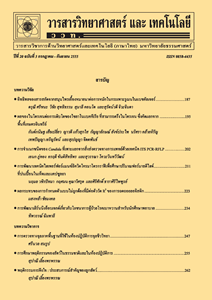พฤกษเคมีและฤทธิ์ทางชีวภาพของผลเสมา
Main Article Content
Abstract
Abstract
This research was aimed to study phytochemical screening test, antioxidant activity, antibacterial activities, cytotoxicity and antiviral (HSV-1) activity of the extracts of O. elatior fruit. The fruit was harvested in December 2015. After separation peeled fruit and flesh from juice, dried and ground samples were successively extracted with ethanol. Both extracts were studied 8 standard preliminary phytochemical tests, including alkaloids, cardiac glycosides, flavonoids, saponins, anthraquinone glycosides, tannins, coumarins, and steroids. The antioxidant activity of the extracts was tested by DPPH assay, and vitamin C was a positive control. The antimicrobial activities were tested by agar diffusion method, against ten human pathogenic microorganisms, including B. subtilis, B. cereus, S. aureus, S. saprophyticus, M. luteus, S. marcescens, E. aerogenes, S. typhimurium, P. vulgaris and P. aeruginosa, and ethanol was a negative control. Cytotoxicity tests were performed against primate cell line (Vero cell) and anti-Herpes simplex virus type 1 by green fluorescent protein (GFP) method, with standards, ellipticine and acyclovir as positive controls, respectively. The results showed that; steroids, deoxy sugars and tannins were found in both extracts. Also they showed the low antioxidant activity with DPPH assay. The IC50±SD of peeled fruit extract was 0.82±33.4 µg/ml and vitamin C was the standard, showed IC50±SD of 2.290±0.30 µg/ml. On the other hand, peel extract inhibited human pathogenic antimicrobial activity against 10 organisms. The peel fruit extract displayed % inhibition higher than that of flesh fruit extract. The highest antimicrobial activities of peel fruit extract were against S. saprophyticus at the minimum concentration of 0.24±0.12 mg/ml. This extract showed the minimum inhibitory concentration against other microorganisms in range of 1.00-6.00 mg/ml. The highest antimicrobial activities of flesh fruit extract were found to against S. saprophyticus at the minimum concentration of 0.75±0.00 mg/ml. This extract showed the minimum concentration inhibited against other microorganisms in range of 1.50-6.00 mg/ml. Both extracts showed no activities against Vero cell line and HSV-1. Notably, standard drugs, ellipticine and acyclovir showed IC50 of 0.75 and 4.29 µg/ml for cytotoxicity and anti-HSV tests, respectively.
Keywords: Opuntia elatior, biological activities, phytochemicals
Article Details
References
[2] Chauhan, S.P., Sheth, N.R., Rathod, I.S., Suhagia, B.N. and Maradia, R.B., 2013, Phytochemical screening of fruits of Opuntia elatior Mill, Am. J. Pharm. Tech. Res. 3(2): 1-6.
[3] Yuyun, Y. and Jamaluddin, 2016, Study of betacyanin level from cactus fruit (Opuntia elatior Mill) in Palu city using spectrophotometry UV-VIS, Int. J. Phyto. Pharm. 6(4): 85-89.
[4] Chauhan, S.P., Sheth, N.R. and Suhagia, B.N., 2015, Analgesic and antiinflamma-tory action of Opuntia elatior Mill fruits, J. Ayurveda Integr. Med. 6(2): 75-81.
[5] Loganayagi, C., Kamal, C. and Sethuraman, M.G., 2014, Opuntiol: An active principle of Opuntia elatior as an ecofriendly Inhibitor of corrosion of mild steel in acid medium, ACS Sustain. Chem. Eng. 2: 606-613.
[6] Ramya, M.C. and Shivanandappa, S.T., 2015, Reversible antifertility effect of Opuntia elatior Mill. fruit extract, Int. J. Reprod. Contracept. Obstet. Gynecol. 4: 392-397.
[7] Ayoola, G.A., Coker, H.A.B., Adesegun, S.A., Adepoju-Bello, A.A., Obaweya, K., Ezennia, E.C., Atangbayila, T.O., 2008, Phytochemical screening and antioxidant activities of some selected medicinal plants used for malaria therapy in Southwestern Nigeria, Trop. J. Pharm. Res. 7: 1019-1024.
[8] Gaikwad, S.A., Kamble, G.S., Devare, S., Deshpande, N.R. and Salvekar, J.P., 2011, In vitro evaluation of free radical scavenging potential of Cassia auriculata L., J. Chem. Pharm. Res. 3: 766-772.
[9] Pukumpuang, W., Thongwai, N. and Tragoolpua. Y., 2012, Total phenolic contents, antibacterial and antioxidant activities of some Thai medicinal plants extracts, J. Med. Plants Res. 6: 4953-4960.
[10] Hunt, L., Jordan, M., De Jesus, M. and Wurm, F.M., 1999, GFP-expressing mammalian cells for fast, sensitive, noninvasive cell growth assessment in a kinetic mode, Biotechnol. Bioeng. 65: 201-205.
[11] Kumaar, A.P.S., Vanitha, J., Venkateshwaran, K., Reddy, K.S. and Karthikeyan, D., 2013, Antibacterial and antifungal activity of Opuntia dillenii (Cactaceae) fruit extract, J. Environ. Nanotechnol. 2(1): 16-19.
[12] Shafiei, S., Kariminik, A. and Hasanabadi, Z., 2013, Antimicrobial activity of methanol extract of Opuntia stricta F., Int. Res. J. Appl. Basic Sci. 7: 907-910.
[13] Rabhi, A., Falleh, H., Limam, F., Ksouri, R., Abdelly, C. and Raies, A., 2013, Upshot of the ripening time on biological activities, phenol content and fatty acid composition of Tunisian Opuntia ficusindica fruit, Afr. J. Biotechnol. 12: 5875-5885.


